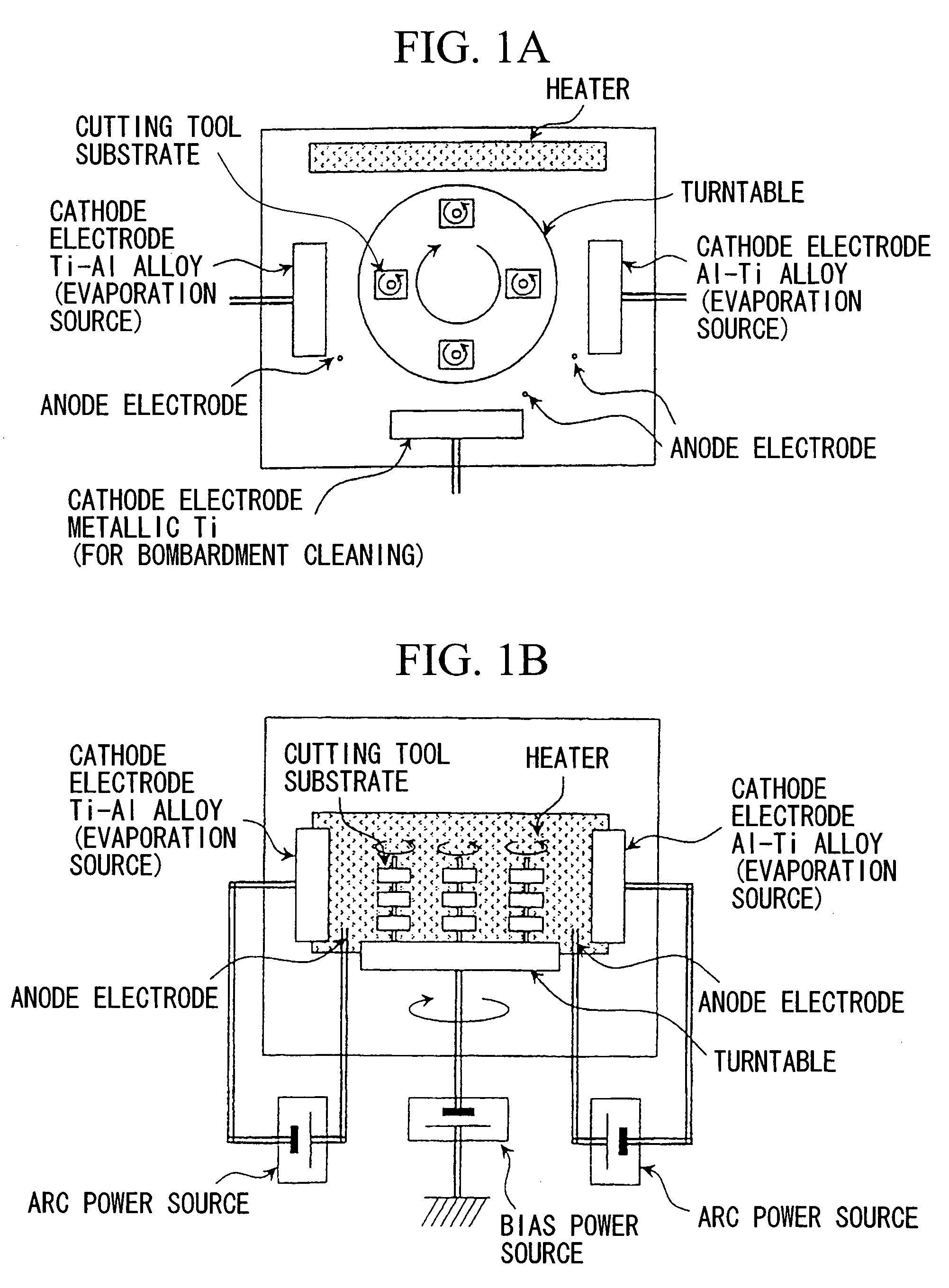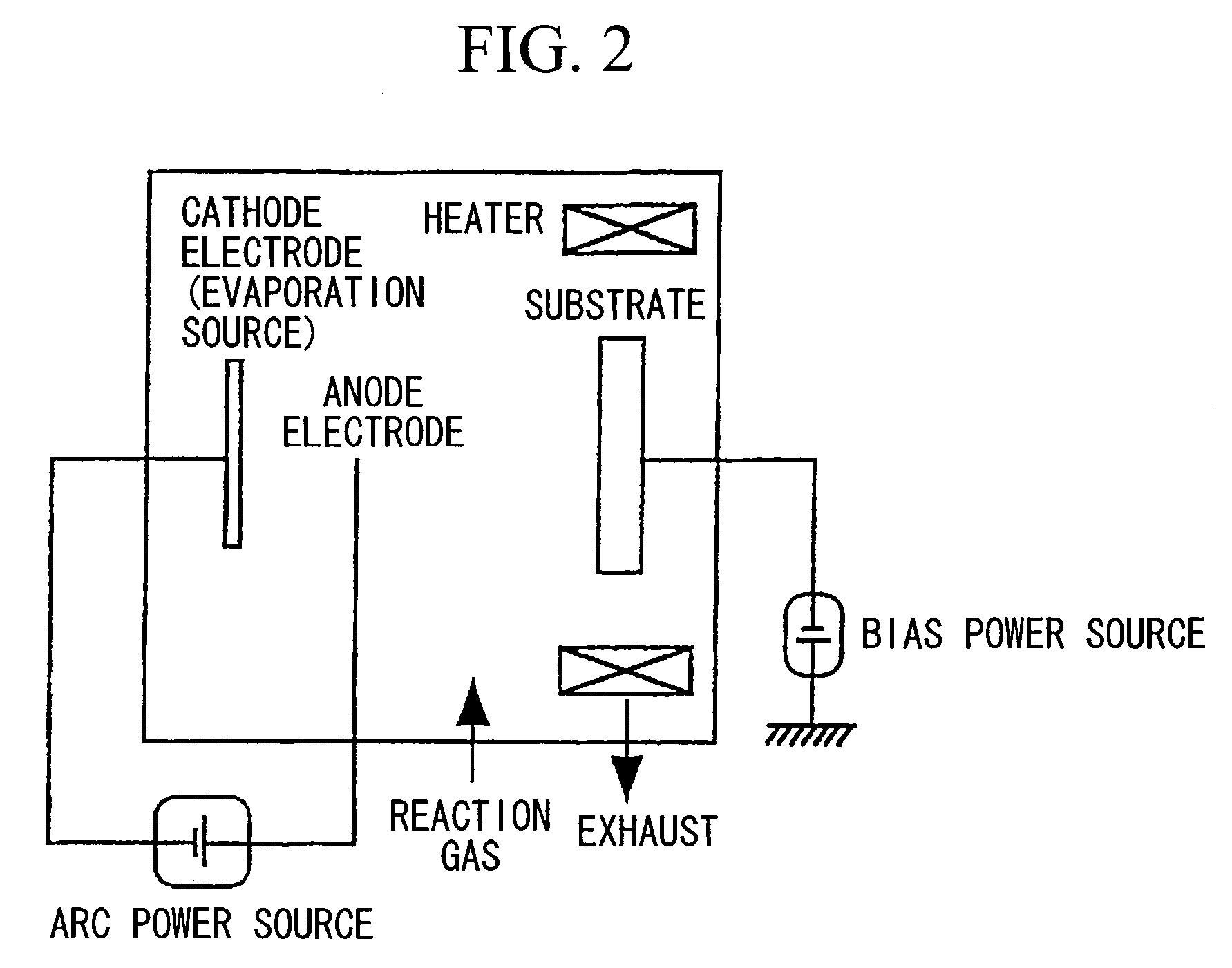Surface-coated cutting tool member having hard coating layer exhibiting superior wear resistance during high speed cutting operation and method for forming hard coating layer on surface of cutting tool
a cutting tool and surface coating technology, applied in the field of surface coating cutting tool parts, can solve the problems of significant progress in the wear resistance of the hard coating layer of the tool, and relatively short operation li
- Summary
- Abstract
- Description
- Claims
- Application Information
AI Technical Summary
Benefits of technology
Problems solved by technology
Method used
Image
Examples
embodiment 1
[0027]First, ingredient powders, i.e., powders of WC, TiC, ZrC, VC, TaC, NbC, Cr3C2, TiN, TaN, and Co, all of which have an average grain size in a range from 1 to 3 μm, were prepared and mixed in accordance with blending ratios shown in TABLE 1. The ingredient powders were mixed under wet conditions using a ball mill for 72 hours, were dried, and were compacted under pressure of 100 MPa so as to form green compacts. The green compacts were held in a vacuum of 6 Pa at a temperature of 1400° C. for 1 hour so as to be sintered. After sintering, a honing process, in which a radius is set to be 0.03, is applied to cutting edge portions of each of the sintered compacts so as to obtain hard metal substrates A-1 to A-10 of WC based hard metal, each of which had an insert shape defined as CNMG120408 in the ISO standard.
[0028]Furthermore, ingredient powders, i.e., powders of TiCN (TiC / TiN=50 / 50 when expressed by weight ratio), Mo2C, ZrC, NbC, TaC, WC, Co, and Ni, all of which had an average ...
embodiment 2
[0053]Ingredient powders, i.e., medium coarse powder of WC having an average grain size of 5.5 μm, fine powder of WC having an average grain size of 0.8 μm, powder of TaC having an average grain size of 1.3 μm, powder of NbC having an average grain size of 1.2 μm, powder of ZrC having an average grain size of 1.2 μm, powder of Cr3C2 having an average grain size of 2.3 μm, powder of VC having an average grain size of 1.5 μm, powder of (Ti, W)C having an average grain size of 1.0 μm, and powder of Co having an average grain size of 1.8 μm, were prepared. The ingredient powders were blended according to the blending ratios shown in TABLE 7, were mixed in acetone after adding wax for 24 hours using a ball mill, were subjected to depressurized drying, and were compacted under a pressure of 100 MPa so as to obtain various green compacts having predetermined shapes. The green compacts were held in a vacuum of 6 Pa while increasing temperature from 1370° C. to 1470° C. at a temperature incr...
embodiment 3
[0077]The three types of sintered bars, i.e., the bars having a diameter of 8 mm (hard metal substrates C-1 to C-3), the bars having a diameter of 13 mm (hard metal substrates C-4 to C-6), and the bars having a diameter of 26 mm (hard metal substrates C-7 and C-8), fabricated in Embodiment 2 were subjected to grinding so as to obtain hard metal substrates (drills) D-1 to D-8, and more specifically, to obtain hard metal substrates D-1 to D-3 having a fluted portion size of 4 mm×13 mm (diameter×length), hard metal substrates D-4 to D-6 having a fluted portion size of 8 mm×22 mm, and hard metal substrates D-7 and D-8 having a fluted portion size of 16 mm×45 mm.
[0078]Next, honing processes were applied to the cutting edges of the hard metal substrates (drills) D-1 to D-8, the hard metal substrates D-1 to D-8 were subjected to ultrasonic cleaning in acetone, were dried, and were accommodated in the arc ion plating apparatus shown in FIGS. 1A and 1B, and then the method of the present inv...
PUM
| Property | Measurement | Unit |
|---|---|---|
| thickness | aaaaa | aaaaa |
| distance | aaaaa | aaaaa |
| temperature | aaaaa | aaaaa |
Abstract
Description
Claims
Application Information
 Login to View More
Login to View More - R&D
- Intellectual Property
- Life Sciences
- Materials
- Tech Scout
- Unparalleled Data Quality
- Higher Quality Content
- 60% Fewer Hallucinations
Browse by: Latest US Patents, China's latest patents, Technical Efficacy Thesaurus, Application Domain, Technology Topic, Popular Technical Reports.
© 2025 PatSnap. All rights reserved.Legal|Privacy policy|Modern Slavery Act Transparency Statement|Sitemap|About US| Contact US: help@patsnap.com



